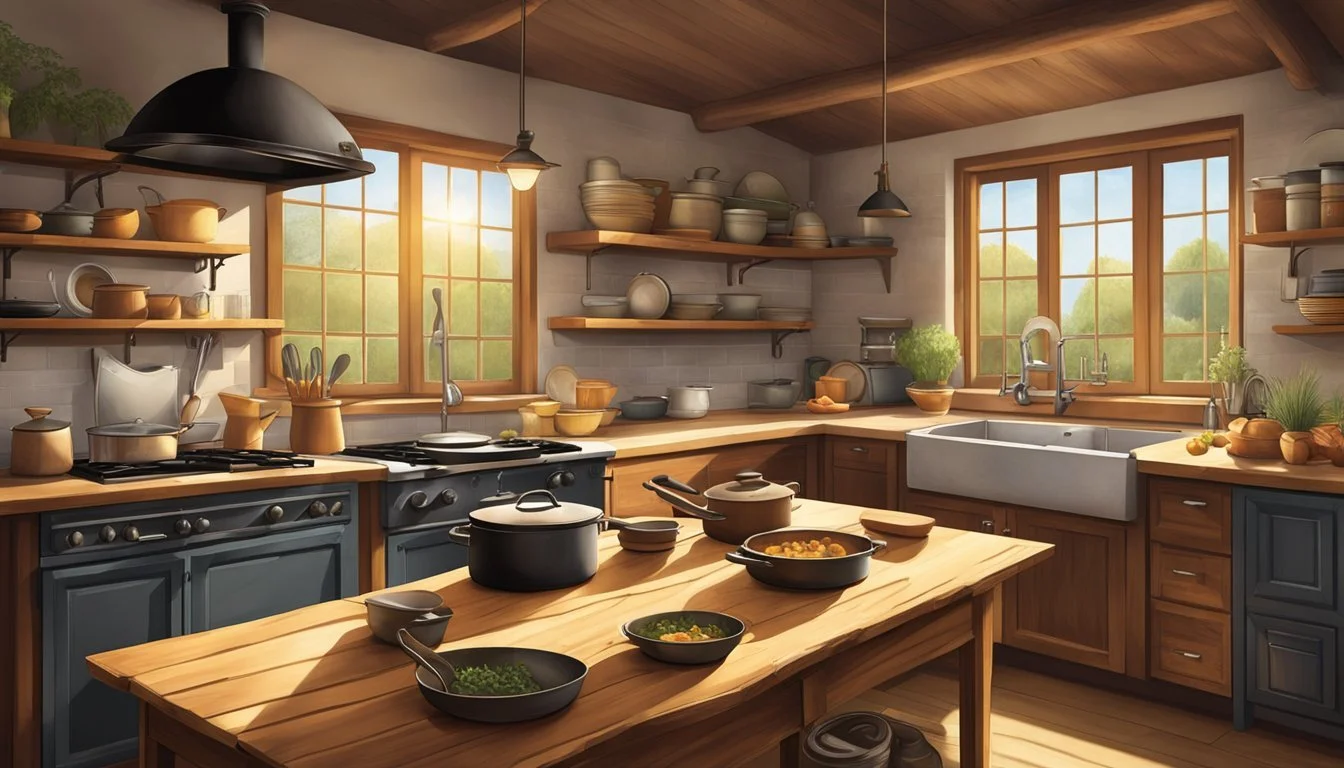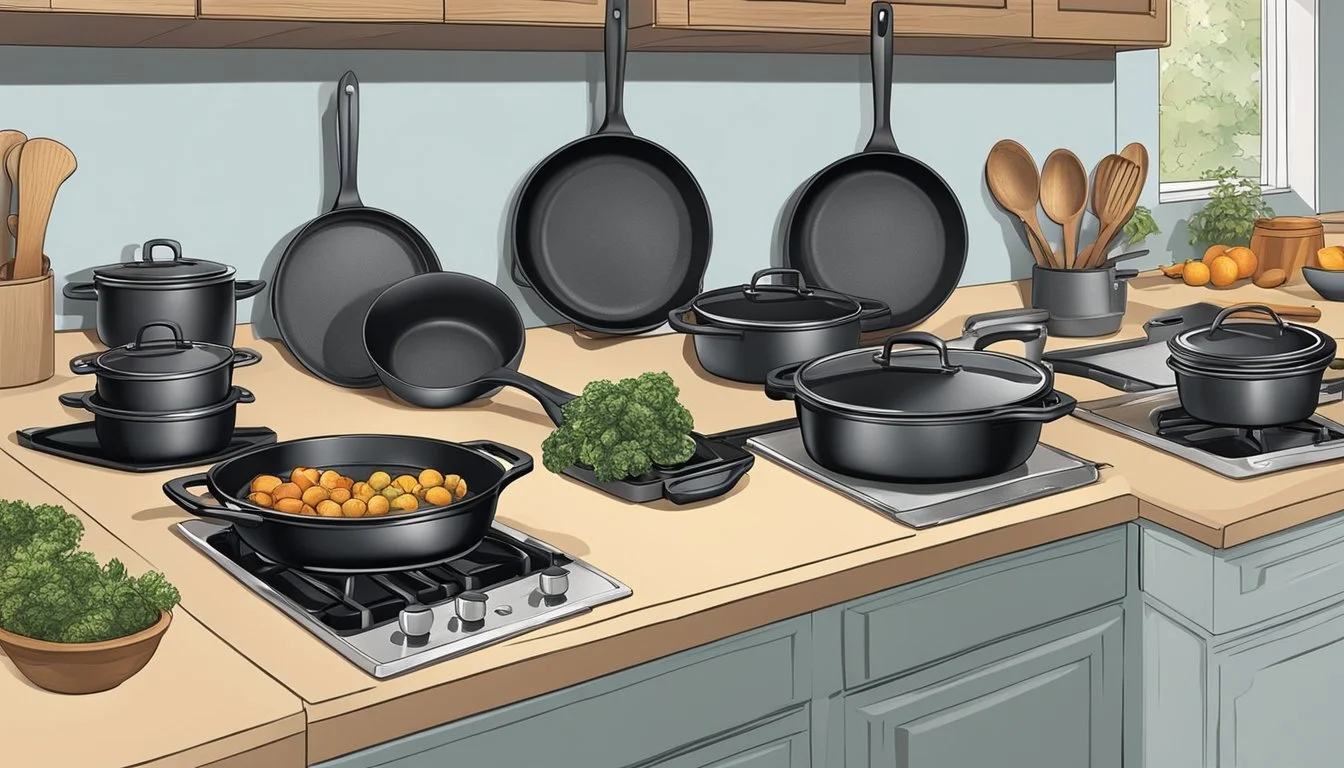The Ultimate Guide to Cast Iron Cookware Sets
Essential Tips for Mastery
Cast iron cookware has a storied history and an enduring presence in the kitchen, dating back to 6th century BCE China. Its widespread use across generations and cultures is testament to its versatility and durability. Cast iron is known for its superior heat retention and even cooking, making it ideal for a variety of dishes, from searing steaks to baking cornbread.
In today's modern kitchen, cast iron cookware sets come in many forms, including traditional raw iron and enameled options. Raw cast iron requires seasoning, a process of coating it with a layer of oil and heating it to create a natural, non-stick surface. This method not only enhances the pan's performance over time but also plays a crucial role in its maintenance. On the other hand, enameled cast iron provides the benefits of traditional cast iron without the need for seasoning, offering a smoother surface that is easier to clean and maintain.
Whether one chooses traditional or enameled versions, cast iron cookware is a valuable investment for the home chef. Its ability to go from stovetop to oven makes it a versatile tool in creating a wide array of dishes. With proper care, these pieces can last for generations, often becoming cherished heirlooms in the family kitchen.
Choosing the perfect cast iron cookware set can elevate your culinary experience, offering durability, versatility, and timeless appeal. The ultimate guide to cast iron cookware sets provides essential insights into care and maintenance, including the importance of proper cleaning cast iron to preserve its quality and non-stick properties for generations to come.
Cast iron cookware sets are ideal for various cooking techniques, from batch cooking to preparing cast iron budget recipes that are both cost-effective and delightful. These sets also facilitate efficient meal prep, allowing for the creation of wholesome and flavorful dishes with ease. Furthermore, cast iron's ability to retain and distribute heat evenly makes it perfect for creating mouthwatering and wholesome gluten-free cast iron baking.
Beyond its culinary applications, cast iron cookware sets are also sought after as cast iron collectibles, appreciated for their historical significance and craftsmanship. Exploring the world of cast iron cookware sets can also dispel common cast iron myths, providing a comprehensive understanding of the benefits and versatility that these kitchen essentials offer.
History and Evolution of Cast Iron Cookware
Cast iron cookware dates back centuries, with its roots deeply embedded in ancient Chinese history. China is recognized as the pioneer in cast iron creation, utilizing the material as early as the 6th century BCE for simple cooking pots. It was during the Han Dynasty, around 200 BCE, that cast iron woks emerged, revolutionizing grain drying and later stir-frying.
By the 16th century, European blacksmiths honed the art, crafting cast iron into various cookware forms using sand molds. This era marked the proliferation of cast iron skillets, pots, and pans across the continent. Heat-retention and distribution properties of cast iron made it a favorite among European households.
The dutch oven, a cast iron cooking pot with a tight-fitting lid, became a versatile tool for both indoor and outdoor cooking during this period. Its ability to maintain steady temperatures made it indispensable for stews and braises.
In the 18th century, advancements such as Abraham Darby's sand casting method streamlined production, directly influencing the prevalence of cast iron cookware. Affordable, durable, and heat-resistant characteristics solidified its place in kitchens worldwide.
Today, enthusiasts appreciate cast iron for its durability and versatility. Maintenance of seasoning, the process of oiling and heating cast iron to build a natural, non-stick surface, underscores the cookware's lasting popularity. Innovation continues, as manufacturers design skillets, dutch ovens, and other cast iron tools to meet the demands of modern cooks while retaining the historic charm that has cooked meals (how long do cooked meals last?) for generations.
Advantages of Cast Iron Cookware
Cast iron cookware sets stand out for their exceptional heat retention and even distribution, versatility across cooking methods, robustness that withstands generations, and the added benefit to iron intake in food.
Superior Heat Retention and Distribution
Cast iron cookware is characterized by its capacity to retain heat exceptionally well and provide even heat distribution. This quality is crucial for cooking applications that require steady temperatures over long periods. It's this even heating that ensures food is cooked thoroughly and uniformly, without hot spots that could cause uneven cooking.
Versatility in Cooking Methods
One of the most compelling benefits of cast iron is its versatility. Cast iron skillets and pots are safe for use on various heat sources, including stovetops, ovens, and even open grills. This makes them ideal for a diverse range of cooking techniques, from stovetop searing to oven-baked goods. They can be applied in baking, grilling, searing, and braising, offering a one-pot solution for most recipes.
Longevity and Durability
The durability of quality cast iron cookware is unmatched. With proper maintenance, these pieces can last a lifetime, often becoming heirlooms passed from generation to generation. Cast iron's robust nature means that, over time, it can even develop a natural non-stick surface, further enhancing its quality and performance with age.
Health and Dietary Benefits
Cast iron cookware can boost dietary iron intake, which is crucial for maintaining healthy blood levels. The material itself is non-reactive, which means that it does not release harmful substances into food during cooking. Instead, small amounts of iron are naturally transferred to the food, providing a health benefit especially for those with iron deficiencies.
Types of Cast Iron Cookware
Cast iron cookware sets come in various shapes and sizes, tailored for different cooking techniques and recipes. Each type offers unique benefits to enhance the cooking experience.
Classic Skillets and Griddles
The cast iron skillet is a fundamental piece in cookware sets, revered for its stellar heat retention and versatility. Skillets come in many sizes, typically ranging from 6 to 12 inches in diameter, making them suitable for everything from frying eggs to searing steaks. Additionally, griddles provide a flat surface ideal for pancakes and bacon, and some feature a reversible design with a grill pan on the opposite side for grilling meats and vegetables.
Dutch Ovens and Bakeware
Dutch ovens are heavy-duty pots with tight-fitting lids that trap moisture, making them perfect for braising, stewing, and baking bread. They range in size from small, 2-quart models, ideal for side dishes, up to 8-quart sizes or larger for main courses. Alongside these, cast iron bakeware, which includes items like cornbread pans and deep baking dishes, delivers consistent heat for even baking and roasting.
Specialty Cast Iron Pieces
In addition to the basics, there are specialty cast iron pieces designed for specific tasks. These include grill pans with raised ridges for char-grilled marks on food, pizza stones for a crisp crust, and aebleskiver pans for Danish pancake balls. Enameled cast iron cookware sets are also available, which provide the benefits of cast iron without the need for seasoning, thanks to a durable enamel coating.
Choosing the Right Cast Iron Cookware
Selecting the ideal cast iron cookware involves understanding the differences in coating, assessing the practicality of various sizes and designs, and considering reputable brands through comparative analysis.
Enameled vs. Traditional Cast Iron
Enameled cast iron provides a natural non-stick surface and requires less maintenance, whereas traditional cast iron boasts durability and a patina that improves with use. Le Creuset and Staub are notable brands offering high-quality enameled options, often favored for their resistance to acidic foods and ease of cleaning. Traditional cast iron, championed by brands like Lodge, is preferred for its heat retention and versatility in building a seasoned coating over time.
Considering Size and Design
The size of cast iron cookware should match the user’s cooking habits and quantity of food typically prepared. A small skillet works well for individual meals, whereas larger pots and pans are best suited for family-sized portions. The design should not be overlooked – a comfortable handle is vital for maneuverability, especially given the heavier weight of cast iron. A combination of skillets, griddles, and Dutch ovens provides a comprehensive set for various cooking methods.
Brand Comparisons and Reviews
When comparing brands, customer reviews are an invaluable resource for gauging quality and performance. Lodge, Le Creuset, and Staub are among the best brands with a proven track record. Lodge offers affordability and is well-regarded for its traditional, pre-seasoned cookware. Le Creuset and Staub are typically higher in price but praised for their superior enamel coatings. Prospective buyers should look at both expert and customer reviews to determine which brand offers the best quality for their cooking needs and budget constraints.
Maintenance and Care of Cast Iron Cookware
Proper maintenance ensures the longevity and non-stick quality of cast iron cookware. Attentive seasoning, cleaning, rust prevention, and the use of appropriate cookware accessories are the cornerstones of cast iron care.
Seasoning Your Cast Iron
Seasoning forms the foundation of cast iron cookware care. It involves coating the cookware with a thin layer of vegetable oil and heating it to create a non-stick surface. For new or scrubbed-clean pans, one should heat the cookware in an oven at 350-400 degrees Fahrenheit for at least an hour. It’s crucial to season repeatedly to maintain the coating.
Cleaning and Storing
After use, the cookware should be cleaned with hot water and, if necessary, a small amount of dish soap. One should avoid abrasive materials; instead, use silicone or wooden utensils to protect the seasoning. Cookware should be thoroughly dried before storing to prevent rusting. For extra protection, a light coat of oil can be applied before it's stored away.
Preventing and Treating Rust
If rust appears, one can remove it using a mixture of equal parts water and vinegar to soak the affected areas. Afterward, the cookware needs to be rinsed, dried, and seasoned to restore its protective coating. Regular use and proper storage are key to preventing rust from forming on the cookware.
Cookware Accessories
For maintenance and cleaning, accessories such as brush scrapers and chainmail cleaners can be used effectively without damaging the cookware’s surface. Silicone handle covers can provide safety while handling hot cookware. When serving or storing, trivets can protect surfaces from heat.
By following these guidelines, one can maintain the durability and enhance the performance of their cast iron cookware.
Cooking Techniques and Recipes
Cast iron cookware excels in heat retention and distribution, which is crucial for mastering various cooking techniques and recipes. Whether one is searing a steak or baking a loaf of bread, understanding how to control the temperature and cook time can lead to delectable results.
Mastering Heat Control
Cast iron's ability to retain and distribute heat makes it ideal for cooking foods that benefit from consistent temperatures. For cooking a steak, it's essential to let the cast iron skillet come up to a high temperature before adding the meat, resulting in a perfectly seared and juicy steak with a crisp crust. In contrast, delicate items like eggs or pancakes require a lower heat to avoid burning. One should always preheat the skillet on a medium setting for a few minutes before starting and adjust the temperature as needed.
Guide to Baking and Roasting
Cast iron bakeware, from Dutch ovens to skillet, broadens the oven's utility by enabling one to bake, roast, and even deep-fry. Preheating the cast iron in the oven will help avoid hot spots and contribute to an even baking experience. Skillets are excellent for making cornbread or deep-dish pizza, while a Dutch oven excels in baking no-knead bread. The temperature limits for cast iron typically surpass what most recipes require, making it safe to use for virtually all baking recipes.
Savory and Sweet Recipe Ideas
Savory Recipes:
Steak: Preheat the skillet for 10 minutes, cook on high for a savory crust.
Bacon: Cook over medium heat, flipping often for evenly cooked, crispy bacon.
Chili: Simmer over low heat for hours in a Dutch oven, allowing flavors to meld.
Sweet Recipes:
Skillet Cookies: Bake in a preheated skillet for a gooey center and crispy edges.
Dutch Baby Pancake: Heat the skillet in the oven, pour in the batter, and bake until puffy.
Cast iron cookware is a versatile tool for both savory and sweet recipes, enabling one to create a variety of dishes from a seared steak to a fluffy Dutch baby pancake. Its unique properties of heat retention and even heat distribution play a critical role in achieving the desired textures and flavors.
Comparative Analysis of Cookware Materials
In this section, we provide a detailed comparison of cast iron cookware against other materials, focusing on aspects such as heat distribution, durability, and specialized uses for different types of cookware.
Cast Iron vs. Carbon Steel
Cast iron is renowned for its even heat distribution and durability, with pieces like the cast iron Dutch oven standing out for their versatility. It typically contains about 98% iron and 2% carbon. Carbon steel, in contrast, is similar yet distinct, consisting of up to 2.1% carbon by weight. While still durable, it is thinner and lighter than cast iron, offering a more responsive cooking surface.
Cast Iron vs. Stainless Steel
When comparing cast iron to stainless steel, the heat retention of cast iron stands out; however, stainless steel is prized for its non-reactive surface. Stainless steel cookware often contains multiple layers for improved heat conduction yet lacks the non-stick qualities of a well-seasoned cast iron pan.
Cast Iron vs. Nonstick Cookware
Cast iron cookware can develop a protective non-stick surface through proper seasoning, while nonstick cookware features a synthetic coating to prevent food from sticking. It's important to note that nonstick surfaces can degrade over time, whereas quality cast iron becomes better with age and use.
Cast Iron vs. Aluminum Cookware
Compared to aluminum cookware, cast iron is significantly heavier and more suited to high-temperature cooking. Aluminum heats up quickly and is lightweight, but it doesn't retain heat as well as cast iron. Enameled cast iron offers a less reactive cooking surface similar to aluminum, which is beneficial when cooking acidic foods.
Common Myths and Questions about Cast Iron Cookware
Myths About Cast Iron
Myth: Cast iron is difficult to maintain.
Fact: It requires seasoning and gentle cleaning but is otherwise low-maintenance.Myth: You should never wash cast iron with soap.
Fact: Mild soap and water can be used occasionally without harming the seasoning.Myth: A well-seasoned cast iron pan is completely non-stick.
Fact: While seasoning improves its non-stick properties, it's not as non-stick as synthetic coatings.Myth: Cast iron pans distribute heat evenly.
Fact: They retain heat well but may not always heat evenly, especially on electric stovetops.
Common Questions
Can cast iron be used on electric stovetops?
Yes, they can be used on all types of stovetops, including electric, though they may heat more slowly on these surfaces.Is it safe to cook acidic foods in cast iron?
Cooking highly acidic foods can strip the seasoning off, but occasional cooking won't ruin the cookware.How versatile is cast iron cookware?
Cast iron is suitable for frying, baking, searing, and more, making it a versatile choice for various cooking methods.
By understanding the realities behind these common myths and questions, users can confidently utilize cast iron cookware and enjoy its benefits in their culinary routines.
Environmental Impact and Sustainability
Cast iron cookware is considered favorable in terms of environmental impact due to its durability and the sustainably-minded processes involved in its production. Sustainability aspects of cast iron include the longevity of the product and the use of recycled materials in its manufacturing. These cookware pieces can last multiple generations, reducing the need for frequent replacements.
Unlike other cookware that requires the mining of new materials, cast iron often incorporates recycled iron and steel. This factor significantly lessens the demand for virgin raw materials, thereby helping to conserve resources. Furthermore, cast iron cookware is recyclable, concluding its life cycle on an eco-friendly note.
From an environmental impact standpoint, cast iron production is less polluting compared to alternatives that release toxic chemicals during manufacturing. The production process reuses byproducts, which mitigates waste, and cast iron itself does not require synthetic coatings, avoiding the emission of harmful fumes during use.
Despite its positive attributes, the production of cast iron does necessitate considerable energy, primarily in the melting and casting processes. However, the trade-off is a product that effectively retains and distributes heat, leading to potential energy savings during cooking.
In summary, cast iron cookware sets represent a sustainable choice for the eco-conscious consumer, thanks to their recyclable nature, reduced material needs, and enduring quality that counters the throwaway culture prevalent in many consumer goods sectors.
The Future of Cast Iron Cookware
As the world embraces both traditional methods and modern technology, cast iron cookware is poised to benefit from forthcoming innovations. Manufacturers are likely to focus on:
Enhanced Coatings: Future cast iron skillets may integrate more advanced seasoning techniques that provide superior non-stick properties while maintaining the cookware's famed durability.
Improved Design: Ergonomic features such as lighter materials or redesigned handles could become more common, making these pans easier to handle and maneuver.
In terms of trends, cast iron cookware is expected to see:
Eco-friendly Production: A shift towards more sustainable manufacturing processes, utilizing recycled materials, is anticipated to reduce the environmental footprint.
Versatile Cookware Sets: As consumers look for multi-use options, sets that cater to a variety of cooking methods – from stove to oven to open fire – are forecasted to be in high demand.
Technological integration is not to be overlooked:
Smart Features: It’s conceivable that smart cast iron cookware which can connect to apps for temperature monitoring and cooking guidance might emerge, reflecting the growing trend of smart kitchens.
In the context of innovation and future trends, it becomes evident that cast iron cookware will continue to evolve, integrating traditional resilience with forward-thinking features. This evolution will ensure that cast iron remains a beloved cornerstone in kitchens worldwide.






